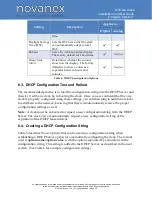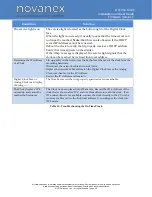
OnTime Clock
Installation and User Guide
Firmware Version 1
All claims based on information publicly available at time of printing. All other product or service names mentioned
in this document may be trademarks of the companies with which they are associated.
© 2015 Novanex, Inc. | All rights reserved | page 17
5. Configuration
5.1. Introduction to SNTP
Simple Network Time Protocol (SNTP) is widely used to synchronize time on
computers. The IT Group within an enterprise usually designates a local server or set of
servers responsible for maintaining accurate time as a time standard for the network.
These servers typically synchronize to a reliable external Internet time source.
The OnTime Clock must be configured with the network location of at least one time
server; the OnTime Clock supports setting an optional secondary time server to be used
in the case that the primary time server is unavailable. The default setting for the
primary time server is an Internet time server operated by Novanex, but this is intended
for temporary use only because IT Groups prefer not to have individual clocks
connecting to the Internet. Your IT Group should specify one or two local SNTP or NTP
time servers or routers to be the primary and optional secondary time servers with
which to synchronize the clock.
5.2. Introduction to the OnTime Management System
Novanex offers a service through its support site to assist in management of your clock
system. This service is available to registered customers at ontime.inovasolutions.com,
and is described on the website.
5.3. Clock Configuration
Once a clock is installed, the next step is to confirm or set the configuration. Though
there are a number of settings you can confirm or change on a clock, you should
concentrate on four configuration items initially. These include:
•
An
IP address
so that the clock can communicate on the network; the clock
supports working with either IPv4 or IPv6. In IPv6 mode, IP addressing must be
statically assigned and DHCP is not available.
•
A
network time server
so that the clock knows with which computer it should
be synchronized.
•
The
local time zone
so that the clock can display the correct local time.
•
The
Daylight Saving Time (DST)
rule so that the clock can automatically adapt
to local DST.
Before working with these settings, however, you have to consider which configuration
method to use. In IPv6 mode, only the third option below is available. In IPv4 mode,
you have three options:
















































